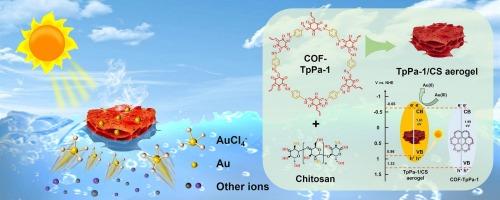Self-floating COF/chitosan aerogel for light-induced enhanced gold recovery
IF 13.2
1区 工程技术
Q1 ENGINEERING, CHEMICAL
引用次数: 0
Abstract
Covalent organic frameworks (COFs) have attracted significant attention as photostimulus-responsive adsorbents for selective gold (Au) recovery. However, their practical scalability is hindered by issues such as particle agglomeration, high costs, and limited light utilization efficiency. Herein, a cost-efficient self-floating COF/chitosan (CS) aerogel is developed that significantly enhances gold recovery efficiency under light irradiation. The incorporation of CS not only reduces the cost, but also endows the resulting COF/CS aerogel with self-floating ability, accelerating the utilization efficiency of light. Benefiting from synergistic effects of coordination interaction, chemical reduction, photothermal, and photocatalytic reduction, this new COF/CS aerogel achieves a high adsorption capacity of 2152 mg g−1 and fast equilibrium kinetics. In addition, the aerogel demonstrates excellent selectivity in recovering gold from real electronic waste (e-waste) leachates. Furthermore, the capture mechanisms of Au(III) by the resulting COF/CS aerogel are verified by spectroscopic and electrochemical analyses. This study underscores the significant potential of the self-floating COF aerogel as a practical solution for the light-induced enhanced extraction of gold from e-waste, positioning it for large-scale applications in sustainable resource management.

自浮COF/壳聚糖气凝胶在光诱导下提高金回收率
共价有机框架(COFs)作为一种光刺激响应吸附剂,在选择性回收金(Au)方面受到了广泛的关注。然而,它们的实际可扩展性受到诸如颗粒团聚、高成本和有限的光利用效率等问题的阻碍。本文研制了一种具有成本效益的自漂浮COF/壳聚糖(CS)气凝胶,该气凝胶在光照射下显著提高了金的回收率。CS的加入不仅降低了成本,而且使得到的COF/CS气凝胶具有自浮能力,提高了光的利用效率。得益于配位相互作用、化学还原、光热和光催化还原的协同效应,这种新型COF/CS气凝胶具有2152 mg g−1的高吸附容量和快速的平衡动力学。此外,该气凝胶在回收真实电子垃圾渗滤液中的金方面表现出优异的选择性。此外,通过光谱和电化学分析验证了COF/CS气凝胶对Au(III)的捕获机理。这项研究强调了自漂浮COF气凝胶作为光诱导强化从电子垃圾中提取黄金的实用解决方案的巨大潜力,将其定位为可持续资源管理中的大规模应用。
本文章由计算机程序翻译,如有差异,请以英文原文为准。
求助全文
约1分钟内获得全文
求助全文
来源期刊

Chemical Engineering Journal
工程技术-工程:化工
CiteScore
21.70
自引率
9.30%
发文量
6781
审稿时长
2.4 months
期刊介绍:
The Chemical Engineering Journal is an international research journal that invites contributions of original and novel fundamental research. It aims to provide an international platform for presenting original fundamental research, interpretative reviews, and discussions on new developments in chemical engineering. The journal welcomes papers that describe novel theory and its practical application, as well as those that demonstrate the transfer of techniques from other disciplines. It also welcomes reports on carefully conducted experimental work that is soundly interpreted. The main focus of the journal is on original and rigorous research results that have broad significance. The Catalysis section within the Chemical Engineering Journal focuses specifically on Experimental and Theoretical studies in the fields of heterogeneous catalysis, molecular catalysis, and biocatalysis. These studies have industrial impact on various sectors such as chemicals, energy, materials, foods, healthcare, and environmental protection.
 求助内容:
求助内容: 应助结果提醒方式:
应助结果提醒方式:


